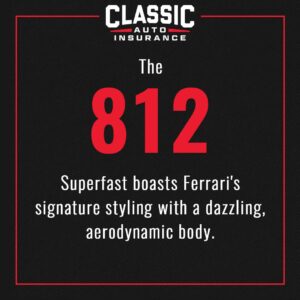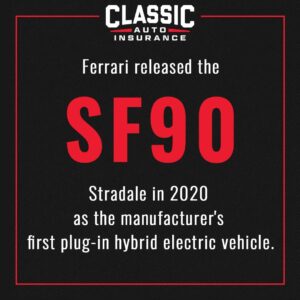Get a Quote
Home » Insurance for Classic & Collector Cars » Exotic Car Insurance » Ferrari Insurance
Ferrari Insurance
 Owning a luxurious Ferrari is an incredible privilege. These sleek, powerful vehicles offer unparalleled performance and head-turning styles.
Owning a luxurious Ferrari is an incredible privilege. These sleek, powerful vehicles offer unparalleled performance and head-turning styles.
If you have a Ferrari, you need insurance coverage designed for high-end vehicles. Standard insurance companies cannot properly insure luxury vehicle models, as they require specialty repairs and rare replacement parts. You need insurance providers that can cover your luxury ride, providing the protection you need.
Whether you own a new Ferrari or a timeless classic, Classic Auto Insurance provides premium insurance to safeguard your vehicle. We feature specialized coverage for Ferrari vehicles and tailor a unique insurance policy to suit your car’s insurance needs. Our comprehensive insurance service offers coverage for every aspect of your vehicle’s value.
Learn more by calling our insurance agents at 888-901-1338, or get a quote here.
Defining Features of a Ferrari
 Ferrari is acclaimed for sophisticated designs, incredible speed performance, and high-quality features. They are remarkable and distinctly unique luxury automobiles.
Ferrari is acclaimed for sophisticated designs, incredible speed performance, and high-quality features. They are remarkable and distinctly unique luxury automobiles.
The Italian automaker’s craftsmanship is based on its racing roots. Racing has been critical to the brand throughout the years, and has included numerous wins like the twelve 24 Hours of Le Mans victories and 249 Formula One wins. Racing roots heavily impacted its signature style, as these vehicles boast sporty, aerodynamic bodies that are aggressive and elegant.
These flashy cars are also enjoyable to drive. With legendary powertrains, including the record-breaking 2.9-liter twin-turbocharged Tipo F120A/F120D 90° V8, Ferraris deliver astounding speed performance and expert handling.
Drivers additionally enjoy exclusivity, as limited production makes them valuable in car collections. This rarity means owners need specialized policies that cover their unique needs and appreciation potential.
With blistering performance, rarity, and unmistakable style, Ferraris are sought-after and recognizable worldwide.
Ferrari 812 Superfast
 The Ferrari 812 Superfast entered the luxury vehicle market in 2017, featuring an impressive front engine. Its 6.5 V12 engine with 7-speed Magna 7DCL750 dual-clutch transmission produces 789 horsepower. The car reaches 211 mph top speed and goes 0 to 60 mph in 2.8 seconds.
The Ferrari 812 Superfast entered the luxury vehicle market in 2017, featuring an impressive front engine. Its 6.5 V12 engine with 7-speed Magna 7DCL750 dual-clutch transmission produces 789 horsepower. The car reaches 211 mph top speed and goes 0 to 60 mph in 2.8 seconds.
The 812 Superfast boasts Ferrari’s signature styling with a dazzling, aerodynamic body. Customization options are offered, including interior trimmings and paint finishes.
Ferrari concluded production in 2024 for its successor, the Ferrari 12Cilindri. The 812 remains a powerhouse reflecting refined Italian craftsmanship.
Ferrari Enzo
The Enzo is a rare classic car, debuting in 2002, named after Ferrari’s founder. The manufacturer produced only 400 Enzo units, with 111 sent to the United States, making them exceedingly valuable in collector markets.
A 6.0 V12 engine with a 6-speed F1 Graziano automated manual transmission powers this ride, producing 651 horsepower at 7,800 rpm and 485 pound-feet of torque at 5,500 rpm.
Ferrari constructed the Enzo’s body from carbon fiber and aluminum honeycomb panels, making it incredibly light. With its lightweight construction and incredible specifications, the car achieved a 218 mph top speed, going 0 to 60 mph in 3.5 seconds.
Ferrari SF90 Stradale
Ferrari released the SF90 Stradale in 2020 as the manufacturer’s first plug-in hybrid electric vehicle. It features the “SF90” marking the 90th anniversary of Scuderia Ferrari.
While eco-friendly, it delivers Ferrari’s signature performance with 986 horsepower at 7,500 rpm and 590 pound-feet of torque at 6,000 rpm. Its top speed is 211 mph, going 0 to 60 mph in 2.5 seconds.
The Stradale achieves performance through its 4.0 L twin-turbocharged V8 engine with three electric motors, channeling power through an 8-speed Magna 8DCL900 dual-clutch transmission.
Why Standard Car Insurance Isn’t Enough for a Ferrari
 Typical car insurance policies suffice for standard vehicles, but high-value vehicles require specialized insurance, especially Ferraris.
Typical car insurance policies suffice for standard vehicles, but high-value vehicles require specialized insurance, especially Ferraris.
Ferraris have specific requirements for maintenance and repair. These vehicles require specialized mechanics with Ferrari experience. Replacing Ferrari parts costs more than standard vehicles, as spare parts are expensive and harder to find. The total cost to repair a Ferrari can be substantial, making proper insurance essential.
Standard auto insurance coverage may not reimburse Ferrari owners for repair costs, meaning they’ll pay out of pocket. While many Ferrari drivers are high net-worth individuals, unexpected repair costs can be financially straining. You can fully cover your ride with premium Ferrari insurance from Classic Auto Insurance. When you file a claim with us, we ensure your vehicle’s true value is protected.
Another important reason for specialized Ferrari insurance is that standard insurers don’t accurately determine fair value prices. Several factors impact Ferrari values, and many insurance companies can’t estimate true worth. Market value fluctuations affect collector vehicle value significantly, making accurate appraisals crucial.
Classic Auto Insurance works with you to determine your Ferrari’s worth, building a personalized policy based on agreed-upon amounts. This ensures sufficient coverage for significant property damage or total loss. If you total your Ferrari, your covered claim includes the full agreed-upon amount minus your deductible. Our claim service handles every detail to protect your investment value.
We feature additional coverage options for high-value assets, including international coverage and nationwide roadside assistance with flatbed towing. We insure vehicles worldwide and provide comprehensive insurance service regardless of location.
How Storage Location Affects a Ferrari Quote
Owning a Ferrari has great benefits, but it’s essential to remember that these rides require protection. Cars exposed to rain, sunlight, extreme heat, and elements suffer costly harm, reducing resale value and leading to depreciation. Owners must protect their luxury vehicles with proper storage. Maintaining a vehicle’s condition preserves the investment value over time and may help to lower insurance costs.
Many insurance companies have requirements for storing classic and luxury vehicles. Lacking sufficient storage may lead to higher premiums, and some insurance companies may refuse to insure your vehicle due to inevitable depreciation.
Proper storage preserves your car, so owners should keep it clean, dry, safe, and climate-controlled.
What May Void Your Ferrari Insurance Policy
Modifications
 Car insurance is legally required for operating your Ferrari, but mistakes can void insurance coverage. Ferrari drivers often modify their cars without informing their insurer. Many car insurance companies require customers to inform them before vehicle changes, as modifications may make cars less safe or more susceptible to theft.
Car insurance is legally required for operating your Ferrari, but mistakes can void insurance coverage. Ferrari drivers often modify their cars without informing their insurer. Many car insurance companies require customers to inform them before vehicle changes, as modifications may make cars less safe or more susceptible to theft.
DUI
Additionally, illegal driving practices void car insurance policies, especially driving under the influence. When drivers operate insured vehicles under the influence of drugs or alcohol, auto insurance providers may refuse to cover the vehicle or cancel policies. Car insurance companies avoid insuring high-risk drivers more likely to be involved in accidents.
Driving under the influence causes devastating accidents, so auto insurance providers frequently cancel policies when drivers receive DUIs. Companies may also reject coverage during the claims process if customers suffer accidents due to impaired driving. Any claim filed under these circumstances may be denied, leaving you to cover damages entirely.
Commercial Use
Ferrari owners using their vehicles for commercial purposes may lose their car insurance coverage. Many car insurance companies view using Ferraris for business purposes as increased risk. Insurance policies may include clauses voiding coverage if vehicles are used for ridesharing, deliveries, or other commercial business purposes.
Electric Ferraris and Future Insurance Costs
 Beyond the powerful SF90 Stradale, many hybrid cars are available in the luxury market, including LaFerrari and 296 GTB. Ferrari also plans to release its first fully electric vehicle in 2026.
Beyond the powerful SF90 Stradale, many hybrid cars are available in the luxury market, including LaFerrari and 296 GTB. Ferrari also plans to release its first fully electric vehicle in 2026.
With quality hybrid and EV cars available, many wonder how insurance rates for electric vehicles compare to traditional, gasoline-powered counterparts.
Unfortunately, insurance coverage for electric vehicles is usually more expensive. Electric vehicles cost more to insure because they have complex components that are expensive to service and replace. Additionally, finding repair shops that fix EV vehicles is challenging. Due to the expensive costs of fixing hybrid or EV Ferraris, finding reliable insurers that deliver exceptional protection at affordable prices is important. Without proper coverage, you may pay significantly more out of pocket for repairs.
Classic Auto Insurance offers customers lower premiums through annual mileage plans, including 1,000, 3,000, and 6,000-mile plans. If you don’t use all your miles in a year, you can roll them over to the next year for free.
Protect Your Ferrari With Classic Auto Insurance
 Ferrari owners trust Classic Auto Insurance to cover their classic ride and keep them running for years. With personalized classic car insurance policies with different coverage options including flexible mileage plans and exclusive benefits, rely on Classic Auto Insurance for the best insurance services.
Ferrari owners trust Classic Auto Insurance to cover their classic ride and keep them running for years. With personalized classic car insurance policies with different coverage options including flexible mileage plans and exclusive benefits, rely on Classic Auto Insurance for the best insurance services.
Learn more about protecting your cherished ride and different coverage types by contacting our insurance agents today for an online quote. Our team has knowledge and expertise in protecting both gas-powered and hybrid Ferraris, helping you get started safeguarding your luxury car.
Don’t fear a total loss. Call us at 888-901-1338 to find out everything we insure, or get an instant quote here.





